While I do like the Lian Li Uni Fans for their ability to be linked together and cut down the amount of wiring needed with RGB fans. But their best feature is the variety of options that Lian Li has. They seem to be always expanding the product stack and they are at it once again, this time with their new Uni Fan TL fans. The TL lineup has 24 different SKUs with both 120 mm and 140 mm options in black and white and with regular or reverse airflow variations. On top of all of that, they have the standard Uni Fan TL as well as Uni Fan TL LCD which they teased earlier this year at Computex. They also have triple packs available with all of the 120 mm sized variations. Today I’m going to check out a triple pack of the LCD model along with three of the 140 mm standard TL options as well to see what they are all about.
Product Name: Lian Li Uni Fan TL and TL LCD
Review Sample Provided by: Lian Li
Written by: Wes Compton
Amazon Affiliate Links:
|
Product Name |
UNI FAN TL LCD (Regular) |
UNI FAN TL LCD (Reverse) |
||||||
|
Color |
Black |
White |
Black |
White |
Black |
White |
Black |
White |
|
Dimensions |
120x125x28mm |
140x145x28mm |
120x125x28mm |
140x145x28mm |
||||
|
Material |
PBT / PC / Aluminum |
PBT / PC / Aluminum |
||||||
|
Rated Voltage |
12V (FAN) / 5V (LED) |
12V (FAN) / 5V (LED) |
||||||
|
Fan Speed |
0, 350-1900 RPM |
0,400-1600 RPM |
0, 350-1900 RPM |
0,400-1600 RPM |
||||
|
Air Pressure |
2.9 mmH2O (Maximum) |
3.5 mmH2O (Maximum) |
2.83 mmH2O (Maximum) |
3.1 mmH2O (Maximum) |
||||
|
Airflow |
62 CFM (Maximum) |
68.1 CFM (Maximum) |
54.3 CFM (Maximum) |
64 CFM (Maximum) |
||||
|
Acoustic Noise |
27 dBA (Maximum) |
28.5 dBA (Maximum) |
31 dBA(Maximum) |
29.4 dBA (Maximum) |
||||
|
Warranty |
3 Years |
3 Years |
||||||
|
Product Name |
UNI FAN TL (Regular) |
UNI FAN TL (Reverse) |
||||||
|
Color |
Black |
White |
Black |
White |
Black |
White |
Black |
White |
|
Dimensions |
120x124x28mm |
140x144x28mm |
120x124x28mm |
140x144x28mm |
||||
|
Material |
PA66 / LCP |
PA66 / LCP |
||||||
|
Rated Voltage |
12V |
12V |
||||||
|
Fan Speed |
0, 200~2600 RPM |
0, 200~1800 RPM |
0, 200~2300 RPM |
0, 200~1800 RPM |
||||
|
Air Pressure |
3.97 mmH2O (Maximum) |
2.34 mmH2O (Maximum) |
2.66 mmH2O (Maximum) |
2.67 mmH2O (Maximum) |
||||
|
Airflow |
90.1 CFM (Maximum) |
103.9 CFM (Maximum) |
83.4 CFM (Maximum) |
101.6 CFM (Maximum) |
||||
|
Acoustic Noise |
33 dBA (Maximum) |
29 dBA (Maximum) |
34 dBA(Maximum) |
31 dBA (Maximum) |
||||
|
Warranty |
3 Years |
3 Years |
||||||
Photos and Features
As I mentioned in the opening, Lian Li is launching a whole variety of fans with their new Uni Fan TL series and sadly I can't show all of them off but I do have a triple pack of the black 120 mm Uni Fan TL LCD fans with the regular fan direction as well as three individual 140 mm white TL fans. This gives us a look at the new LCD models as well as the standard TL model but because they are different sizes we can’t compare them against.

The packaging for the triple pack of Uni Fan TL LCD 120 has the same styling that all of the Uni Fans have had. They use light blue trim on the sides that carries over to the edge of the front and then a black background. The front of the box then has a picture of the three fans all linked together and up and running including showing the center LCD screens with three different designs on them. The model name is in the bottom left corner with the Lian Li branding being small and up in the top left. The fan color is in the bottom right and the top right shows that there are three fans inside and highlights the three-year warranty. The side of the box has another picture of the fans with lines pointing out some of the key features and a picture showing the dimensions of the three fans when linked together. Then the back of the box has a specification listing and a feature list along with single pictures of one fan and the controller to show you what is inside the box.




When you open the box up they have foam across most of the top and on the side you have the cable and mounting screws. Under the foam, you will find the three fans are all individually bagged and have foam between each fan and on the outside as well. This is different than past Uni Fans which normally come in bubble wrap bags, the extra protection helps protect the LCD screens and each foam layer has a cutout so they don’t touch the screen as well. Beyond the three fans you get one connection cable in black to match the fans, a baggie of screws, a box with the controller, and a black and white instruction manual.



Inside the controller box, the controller comes with plastic on the glossy areas and also inside of a reclosable plastic bag. Like with past Uni Fan controllers, it has 7 pin connections on both sides, four in total. These hook up to the fans. The connections beyond that have changed up though and all of the wires are hard wired. You have one USB 2.0 header connection which is sleeved, one three-pin addressable RGB plug that goes to your motherboard, and a PWM fan connection as well. The last two are used when you want to give up control to your motherboard’s software. The last cable is sleeved as well and is the power cable. For past Lian Li controllers, this would be a SATA power connection but I was surprised to find that this time around they have gone with a 6-pin PCI power connection like your video card uses. I assume that the screens have the power requirements up higher than normal but I will be diving into that in our performance section to see. The controller has a spot on the bottom for the included double-sided magnetic pad. You can use the double-sided tape on both sides to mount it or if your case is steel use it as a magnet to mount it.








The Uni Fan TL LCD 120 is 120 mm wide 125 mm tall, and 28 mm thick. For comparison with the standard TL fan, it is 1 mm taller but compared with a standard 120 mm fan which would be 120 mm wide and tall and 25 mm thick the Uni Fan TL LCD 120 is thicker and taller. The fan is available in both black and white models and with our black model, you can see the white translucent RGB diffusers that run along the top and bottom of the fan. Each corner has an anti-vibration pad on it and if you look closely each pad has a removable pad for installing screws. The fan itself has 9 blades and is a little smaller than your standard 120 mm fan with the outer housing being a lot thicker. The fan is a combination of PBT, Polycarbonate, and Aluminum. The big feature of this model is of course the center-mounted LCD screen on the one side. This is the main reason for the fans also being available in regular or reverse airflow models, giving you more control of where the screen faces. The display is 1.6 inches and supports a 400 x 400 resolution. You can display GIFs, MP4, JPG, and PNG files or have them show system status information. One thing to note is that the screen which has a thick bezel around it doesn’t spin with the fans and is wider than a normal fan center section. So the fan area from the side to the outside of the fan is just 30 mm wide, cutting into your airflow space. I wish I had one of the 120 non-LCD TL fans for comparison but this was larger than the center section on the 140 mm TL fans.







The back of the Uni Fan TL LCD 120 has the same squared-off styling on the back side of the fan including the same hockey stick-like accents that zig-zag across the top and bottom of the fan. This side doesn’t have the LCD screen however and it where the mounts that hold the fan motor in the center run. These mounts are a little wider than normal, especially on the top and bottom to help with the extra weight of the screen and the wires needed as well. The center has the Uni Fan TL LCD branding on it as well as the Lian Li logo.

The top and bottom edges of the Uni Fan TL LCD 120 have a similar side design as what we saw on the Uni Fan SL-Infinity fans with an infinity mirror design. Only this design also has diffused light bars that run along the edge of the mirror from end to end of the fan and the mirror itself runs to the end of the fan where there was a gap on the SL-Infinity design. Eventually, this is a combination of multiple Uni Fan designs and I think it takes the best from each design. On the sides, one side of the fan has 7 contact bars and two T-shaped hooks. Those hooks can be twisted to be removed. The other side has 7 spring-loaded pins that line up with the other side and T-shaped slots in the housing to link the fans together without any wiring. What is new here though is the light diffusers that we saw on the top and bottom edge carry on down the ends and wrap around the rubber vibration pads on each corner, bringing lighting to the ends of the fans. I also put together a picture showing how the pins line up and a picture of two of the three fans linked together. A close look at that picture does show a small gap near the center of the fans but what I like is that you can see how the hockey stick light bars across the front and back of the fans link together when the fans are linked together.






The packaging for the individually packaged non-LCD Uni Fan TL 140 fans that Lian Li also sent over has the same black background with a light blue trim. The front of the packaging has a large picture of the fan all lit up and running but this does have a few swoops in the background as well for some reason. The model name is the largest font with the Lian Li logo being the next largest in the top left corner. The top right shows that this is just one 140 mm fan and highlights the 3-year warranty and the bottom right corner has the fan color which this time is white. This box isn’t as thick as the triple fan models so it doesn’t have room for the extra pictures and information but there is a single picture of the fan on the back along with the specifications. The back also has a feature list as well as a link to the controller software. The fan comes wrapped in the bubble wrap bag and you get a bag with two cables, one goes from the fan to a controller and the other can link the fans together which I’m always surprised the triple fan kit doesn’t come with to let you put a single fan on a rear exit mount in your case. The wires are color-matched to the white fan with their sleeving and the main connection but black at the controller end. You also get a small bag with four black mounting screws and a black and white instructions sheet.




The Uni Fan TL 140 is 140 mm wide, 144 mm tall, and 28 mm tall. This is one mm shorter than the LCD model but like all of the Uni Fans, this design is thicker than your average fan by 3 mm and slightly taller as well. Lian Li does compensate for that with the recessed screw mounts that are down inside of the rubber anti-vibration pads on each corner. That also allows them to hide the screws with the pop-out covers for that clean look. The design of the Uni Fan TL 140 isn’t really any different than what we saw with the Uni Fan TL LCD 120 other than being larger and not having the LCD screen in the center. It has the same hockey stick-like light bars at the top and bottom of the fan and the thicker than normal housing. The 140 mm size has the same 9 blades to its fan design but the fan itself has longer blades which show a little more curve because of the extra length. The fan blades for the non-LCD model does use Liquid Crystal Polymer for the fan blades which is different and allows for these to be tighter to the outer housing. Not having the LCD screen in the middle also helps open things up for airflow, those covered up some of the airflow on the LCD model, especially with the 120 mm size. The screen might look a little more in line with the 140 mm model really. Without the screen, the center of the fan has a plastic cover but Lian Li has left the center of that cover clear so you can see the fluid dynamic bearing. The white looks especially good, I think I like it more than the black design but that is going to depend on what will match the rest of your build.







The back of the Uni Fan TL 140 has the same light bars as well, in total, each TL fan with or without the LCD screen has a total of 26 LEDs for their addressable RGB lighting. The back here has the same thicker support structure to hold the motor in place in the center but only one is thick and running cables in it whereas the LCD models have two. Then in the center is another clear cap, this time with the TL model name on it and letting us see that bearing once again.


I spoke about it a lot when we took a look at the Uni Fan TL LCD 120 up above but the side design on the top and bottom edge of the Uni Fan TL 140 combined the infinity mirror design with the diffused lightbar designs of multiple Uni-Fan designs for a new and even better look. The mirror runs all the way to the end, as do the light diffusers which lets multiple linked fans look continuous. The lighting wraps around onto the ends under the rubber mounts on both sides so the ends of a line of Uni-Fans won’t just stop. Then to link everything together this has the same T bar linking design with T slots on one side and two removable T bars on the other side to latch from fan to fan. They are removable to make sure they don’t get in the way at the end of your line of fans or if you use just one. You then have the 7 contacts on one side and 7 matching pins on the other side but for the individual fans like this, each does come with a plastic cover installed to keep the pins safe.






Here is a look at the Uni Fan TL 140 fans linked together as well as a few comparison shots with the Uni Fan TL LCD 120 as well.



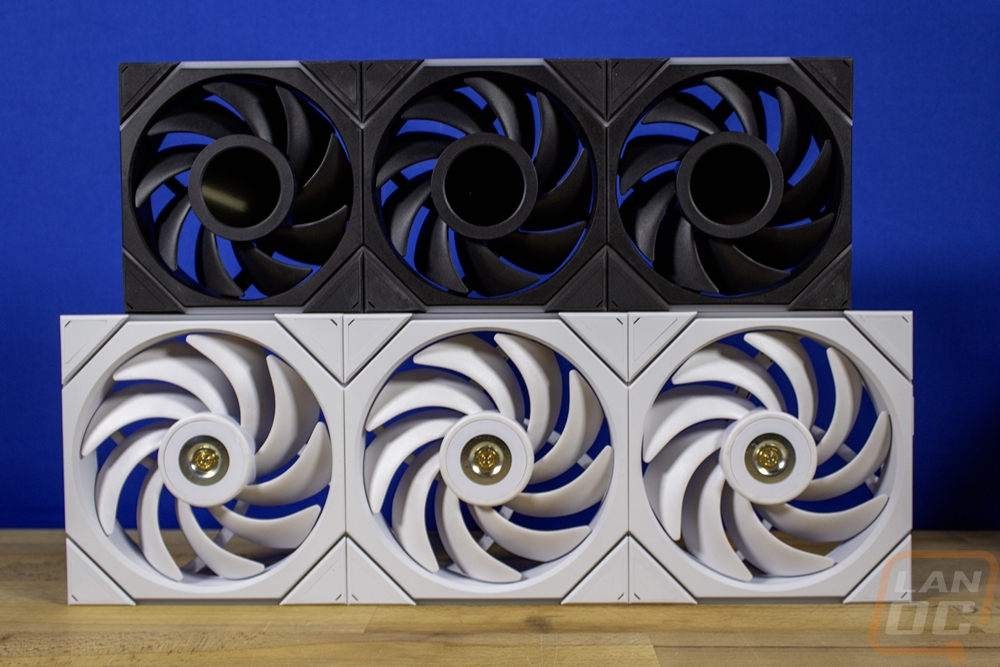
I didn’t notice it when taking my initial pictures but when I got into testing I did notice that the LCD model and the Uni Fan TL 140 without the LCD did have different cable designs which surprised me. The black connection is for the LCD triple pack and this will only mount to the one end of your fans that has the spring-loaded pins. The other design on the other hand can work on either end which is a really useful change. The cable has both the contacts and the spring-loaded pins in the cable itself. These different designs don’t work with each other because the pins are moved and you need a recessed area for the pins in the plug to fit but I hope they do that in the future. I will talk about it more but I should also note that the TL and TL LCD fans can be linked together but only in one specific way.


Performance
To get into performance testing, the first thing we have to check out is the software that controls everything. That plays the biggest role in your overall experience and what features you will have which with a product like the Uni Fan TL LCD especially makes or breaks everything. Both fans use the Lian Li L-Connect 3 software but it does use a different revision than past fans have used. I’m hoping after launch that will be combined but I know with the LCD on their latest AIO cooler they have a different revision listed on the website so we will have to see.
With the software installed the first page is the system resources page which has graphs showing your CPU, GPU, RAM, and Storage usage as well as temperatures, clock speeds, and fan speeds where they apply.
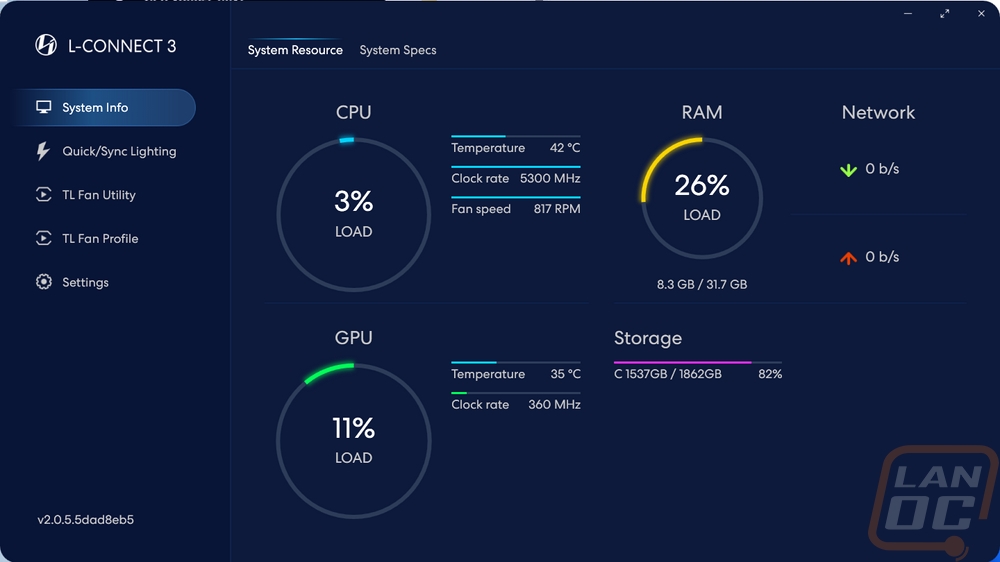
The quick sync lighting page is an overall lighting control page. This can be a little confusing but this lets you change to a few lighting effects along with their settings to adjust things like speeds, color, and direction all in one place to change all of your Lian Li controlled lighting. This is also where you can give up lighting control to your motherboard with the switch up top.
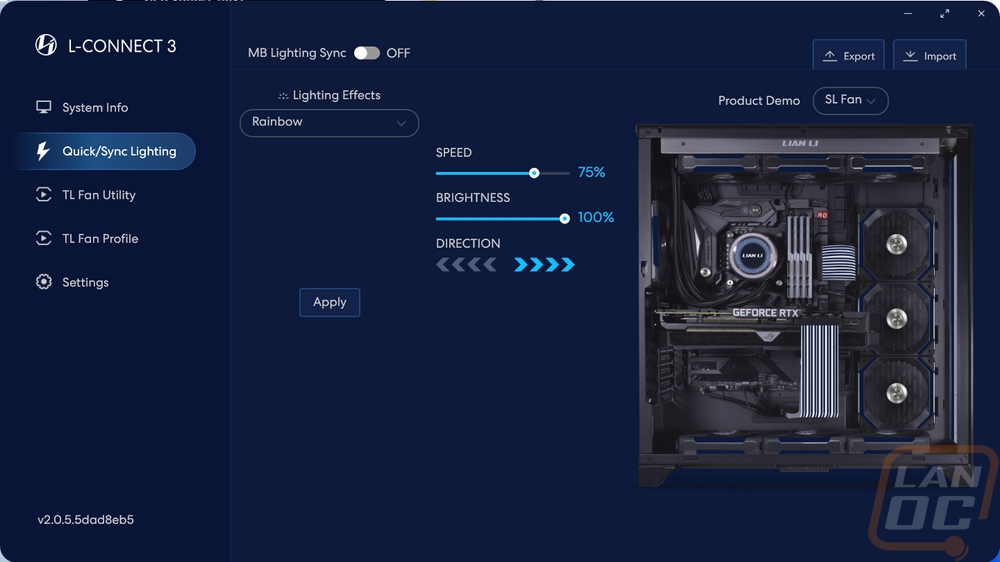
The TL Fan Utility is the first of two pages specific to controlling anything hooked up to the controller included with the triple fan pack. The first page is where you can change any of the lighting settings and also dive into controlling the LCD screen on the TL LCD models. In this case, I have both the triple TL LCD 120 fans hooked up as well as the three TL 140 fans so you can see the difference between the controls for both and how they are on two different channels. The main page here shows the number of fans on each and their current lighting and fan settings. Then down towards the bottom, there is a drop-down menu to pick from a long list of lighting effects and you can change the colors used, speeds, brightness, directions, and anything else. The same settings are available for the Uni Fan TL LCD fans as well. But those fans have two more settings pages over on the left. One for the LCD screen and another for startup. The LCD screen page shows the current effect, picture, or video being shown on each LCD in order. Below each preview, you can rotate the image to help line it up in your PC. Then to the right is a dropdown that lets you pick from pictures, dynamic or videos, and sensor readings. With the pictures and videos, you can upload your own designs. I do wish they had a variety of basic pictures at least, even the Lian Li logo that is run by default isn’t listed here. The sensor readouts let you pick from CPU or GPU temperature or load and fan RPM. You have three styles to the right to pick from but only two work right now and with those you can select the colors that it uses.
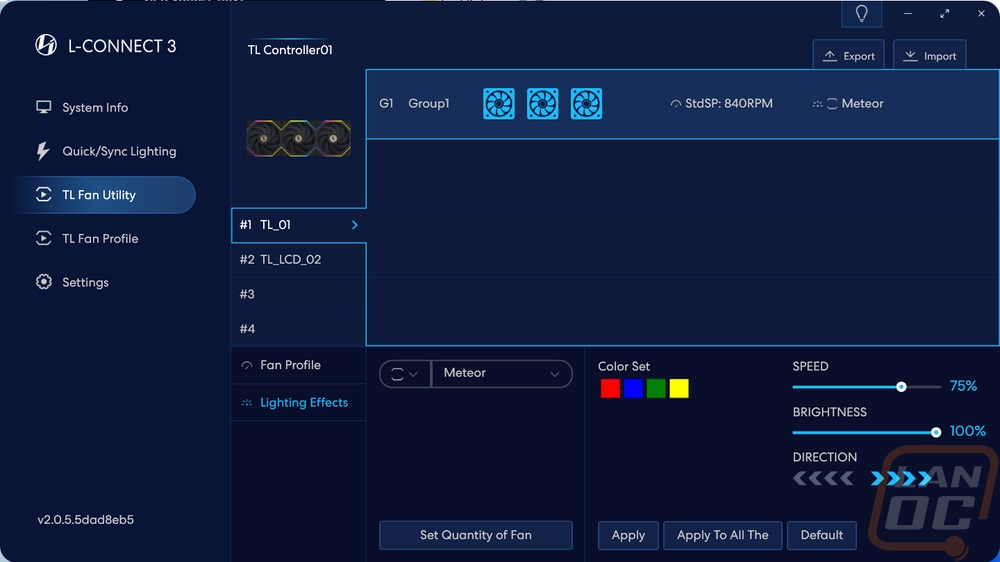

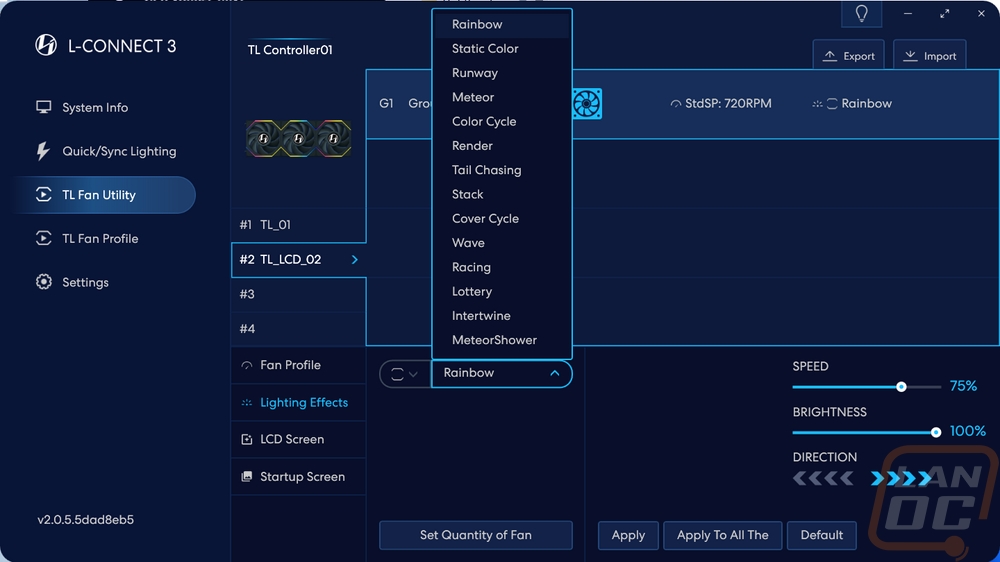
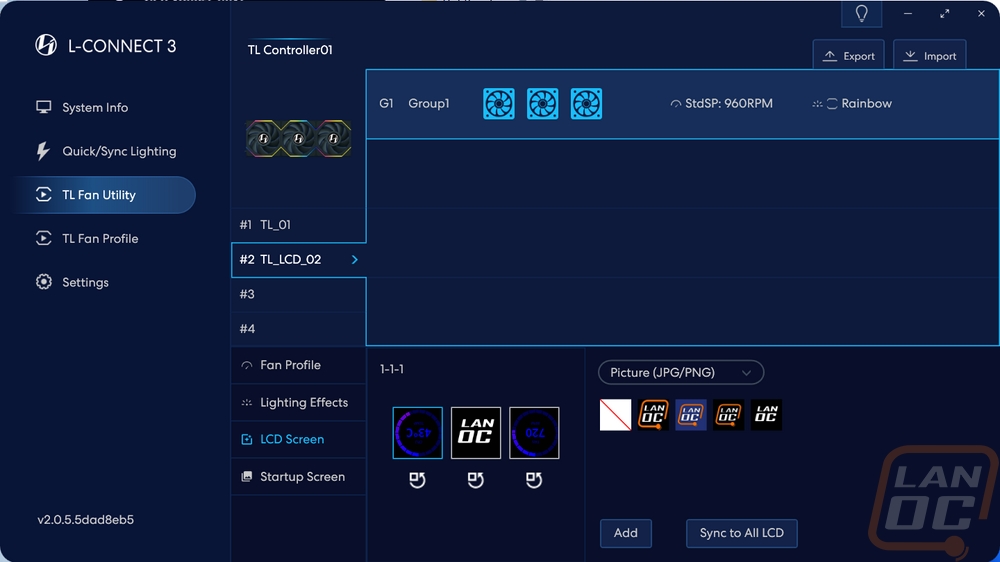

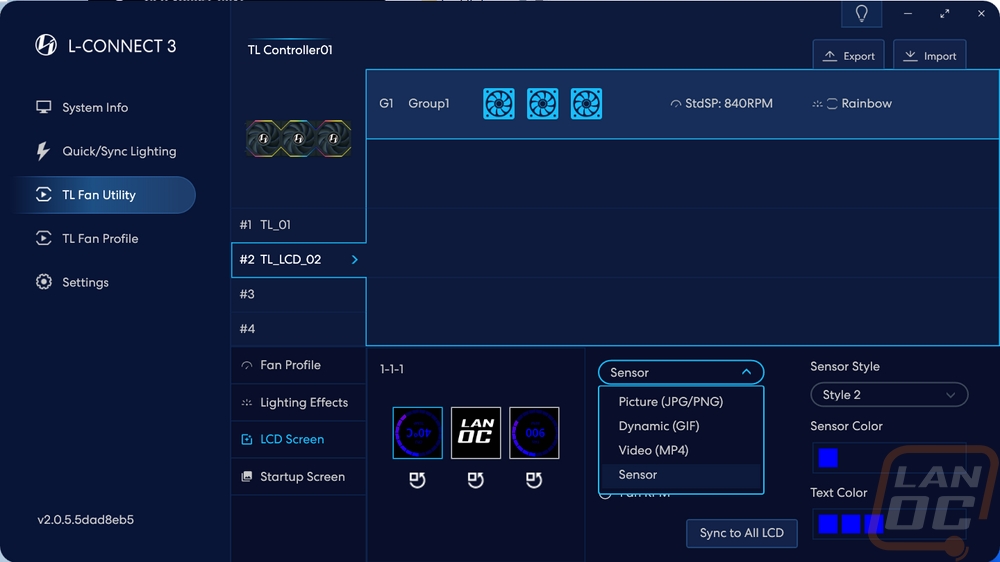
The last page is the TL Fan Profile. This is where you adjust the fan settings. You can turn on a start and stop which will turn the fans off at specific temperatures. You can pick what device the fans use to dictate temperatures which is nice. Everything uses CPU temps but if you have a good cooler your case most likely is getting more heat from your GPU. From there, you have a list of profiles on the left that you can pick including custom profiles. With custom profiles, you can set a speed all of the time or map out a full profile that best fits what you need. Then you can apply it to one set of fans or to all of the Lian Li controlled fans. Up top, you can turn on motherboard sync which will just do whatever your motherboard says to do if you would prefer to control everything from that software.
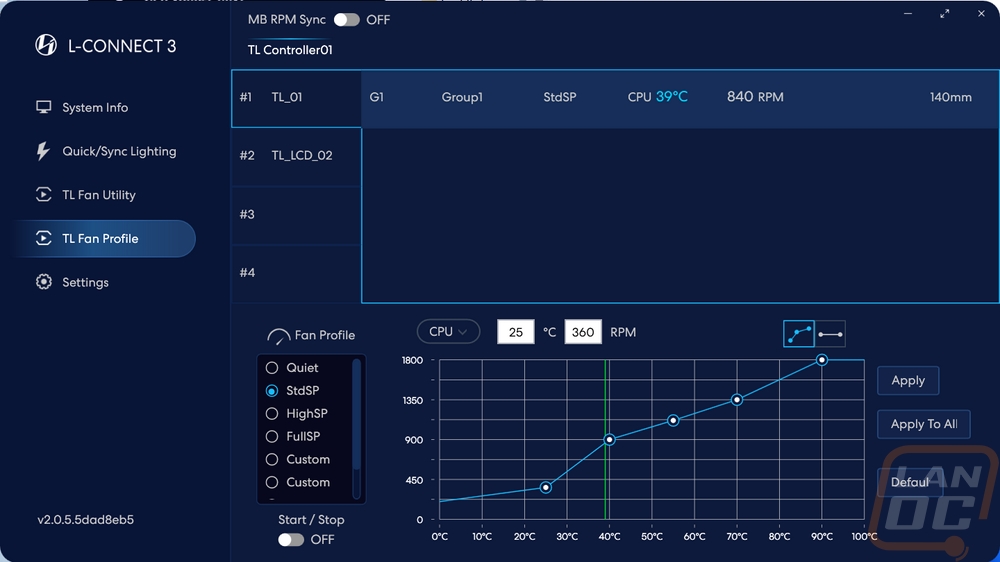
While to some people, the fan performance is the biggest priority, with the Uni Fan designs and especially here with the TL LCD model aesthetics are the biggest priority with the fan design. With that I wanted to check out the lighting and how the LCD worked before diving into any of the fan specs or performance. There are two halves to this story really. You have the addressable RGB lighting that runs across the top and bottom of the front and back of the fans along with all of our outer edges as well then you have the LCD. First up let's check out the RGB lighting and like the Uni Fan SL design the two hockey stick shapes above and below the fan look great but for the TL design, Lian Li has widened that diffuser more out to the edge of the fan which looks even better. When you have the fans linked together the effects just blend in together making the linked fans look like one device, not multiple fans next to each other. That lighting then wraps up onto the top edge as well which is the big change from the SL Infinity design. Not only do you have the infinity mirror still but around that you have diffused lighting as well which again is wider and more lighting than in the past. All of that also runs to the end which looks great and wraps around to the sides which for the linked fans will be hidden but does look good at the ends of your linked fans. The infinity mirror design gives the effect that you have more lighting as well as it goes down into the infinite.







We are all here for the LCD though right? It’s funny because just a few years ago having a screen on top of the pump on an AIO cooler was crazy and even still it is great to have. But it is hard to wrap your head around a screen in the middle of a fan. You have the spinning blade behind it and the motor design itself makes it very hard to pass through the cables needed to power the display but Lian Li has all of that figured out. The 400 x 400 resolution 1.6-inch display in the middle of each fan is bright and does a good job with the blacks. When they first boot up with the Lian Li logo I can see someone just thinking these are backlit logos but once you change things out there won’t be any doubt. It did take a little time to figure out the spacing, with the resolution being a square and the display being a circle there is going to be a lot cut off from some designs and I found that you need to offset things slightly to the bottom left not be exactly centered. Once I had designs that fit the aspect ratio tossing them on the fans was easy. It will take a lot more work to get good animated designs however and like I said with the software section. I would love it if they had more designs come by default, especially animated designs. Getting the LanOC logo on there was cool though and if you theme out your PC or name it this is a great way to tie that in. Even then you still could run one or two of the sensor readouts as well. The two working designs look good but this is another area that software improvements over time can really change things. Adding even more readouts going beyond the standard PC information could be cool. Stock tickers, local weather, or even just random pictures could be options. Being able to add pictures into the background of the current sensors could be nice as well. The two displays do a good job of making things visible with the numbers in the center and the outer ring being used as a graph. Really the possibilities are endless assuming Lian Li continues to support it all and given how good of a job they have done with the Uni Fans on the software side up to now it is promising.






Of course, we can’t forget about performance and without having a full setup for airflow my testing was focused on noise levels but I did want to touch on some of the listed airflow performance numbers from Lian Li as well. With so many SKUs from the TL lineup, my focus is just on the two fans that I have on hand but know that the numbers for their reverse flow fans are different. The numbers between the LCD and non-LCD models are different as well. The TL LCD 120 has a fan speed of 350 RPM up to 1900 RPM, the non-LCD model gets a lot crazier running from 0 to 2600 RPM. The LCD 120 maxes is air pressure out at 2.9 mmH2O and has an airflow of 62 CFM and is rated at 27 dBA at full speed from Lian Li. The non-LCD model with its higher RPM can pul 3.97 mmH2O for air pressure, flows a crazy 90.1 CFM, and is 33 dBA. For the 140 mm TL fans that they sent, they can run from o to 1800 RPM. Their air pressure is 2.34 mmH2O and because of their larger size, they flow 103.9 CFM at full speed at 29 dBA.
For testing, I set the decibel meter up at 14 inches away from the fans. My testing covered 100% and 50% fan speeds as well as three of the Lian Li fan profiles. For those three profiles, I had the CPU under load with AIDA64’s stress test with the CPU workload so we could get an idea of what to expect noise level wise when under full load. I also tested with 1 fan and 3 fans for comparison and documented the listed fan RPM for each. There is some variation as the CPU temperatures did range from 58c up to 62c when testing but most were similar. Unlike with the P28 fans, I didn’t see any issues with fan speed dropping as more and more fans were running. In fact when I ran all six fans both fans showed the higher 1860 RPM even though the 140 mm fans don’t normally go that high. So how did the Uni Fan TL fans perform? Well the TL LCD 120 fans came in a lot closer to the 140mm non-LCD fans than I expected across the board but as fan speeds were turned up that gap did open up. The slightly lower RPM and less restriction on the 140 mm fans that didn’t have a screen in the way ran at 39.7 dB at full speed to 41.8 dB for the TL LCD 120 when comparing one fan to one fan. Having three fans really ramped things up with the 120 model going from 41.8 dB up to 47.5 dB and the 140 mm model going from 39.7 dB up to 45.1 dB. More than anything though my testing showed that anything other than full speed the fans were a lot quieter than expected.
|
Fan Speed Setting |
Decibels |
RPM |
|
Uni Fan TL LCD 120 – 1 Fan |
||
|
50% Fan Speed |
32.1 |
900 RPM |
|
Quiet Setting |
32.3 |
960 RPM |
|
StdSP Setting |
33.2 |
1260 RPM |
|
HighSP Setting |
35.3 |
1440 RPM |
|
FullSP Setting |
41.8 dB |
1860 RPM |
|
Uni Fan TL LCD 120 – 3 Fans |
||
|
50% Fan Speed |
32.5 |
900 RPM |
|
Quiet Setting |
32.5 |
960 RPM |
|
StdSP Setting |
36.9 |
1260 RPM |
|
HighSP Setting |
39.4 |
1500 RPM |
|
FullSP Setting |
47.5 |
1860 RPM |
|
Uni Fan TL 140 – 1 Fan |
||
|
50% Fan Speed |
32.1 |
840 RPM |
|
Quiet Setting |
32.1 |
840 RPM |
|
StdSP Setting |
32.9 |
1140 RPM |
|
HighSP Setting |
34.6 |
1380 RPM |
|
FullSP Setting |
39.7 |
1740 RPM |
|
Uni Fan TL 140 – 3 Fans |
||
|
50% Fan Speed |
32.9 |
840 RPM |
|
Quiet Setting |
32.9 |
840 RPM |
|
StdSP Setting |
34.5 |
1140 RPM |
|
HighSP Setting |
38.9 |
1320 RPM |
|
FullSP Setting |
45.1 |
1740 RPM |
Beyond all of that, there are a few other aspects of the Uni Fan TL and Uni Fan TL LCD that I should also touch on. The biggest of those is the experience with wiring and installation. I’ve spoken about it a lot with other fans but RGB fans are a wiring nightmare. Lian Li with the Uni Fans and a few other companies with their own variation on daisy chaining fans together has helped a lot with that. In the past, you had to have two long wires for each fan and then a controller that had its own wiring mess. With this setup, you could have just one wire that runs from the fans to the controller. If you have fans in more than one location you can link them together as well with the cable included with the single fans. There are a few complications though with the TL LCDs in the mix. These do pull more power and they use 12 volts for the fan and 5 volts for the display. Lian Li hasn’t provided any of their amperage numbers but it's clear given the new power plug that more power was needed than a SATA power connection could provide. I’m still not a big fan of having to use that cable though, I wish using more than one SATA plug could have been an option. They have let us know the limits on how many fans you can hook up. The one controller can handle a total of 7 TL LCD fans in total and only three can be used per plug. The standard TL fans on the other hand can run up to 10 on that same controller. You also can’t directly connect the TL and TL LCD fans together and have them work. It is possible for them to link to each other but it won’t pass the signal through and the cable designs don’t work together. You can however do what I did in our testing and run them both on the same controller.
Overall and Final Verdict
Lian Li continues to innovate and offer different fan designs with their Uni Fan line of fans and their latest fans, the new TL and TL LCD fans are a great example of that. The new lineup is surprisingly diverse with 24 different SKUs and even when you aren’t including the triple fan kits that come with a controller there are 16 different models once you include the black and white color options, 120 mm and 140 mm sizes, reverse and regular airflow directions, and LCD and non-LCD models. They all have the Uni Fan linking design that cuts back significantly on the wiring needed. The new design also has a great-looking lighting design that improves on previous fan designs like the SL-Infinity but now wraps around the edges and ends of the fan while still including the infinity mirror design which now butts up to the edge. All of that means that the lighting and the mirrored design now carry on from fan to fan and is visible from more angles. Then on top of that the TL LCD fans have a display on the center section of the fan that you can customize to show your own videos or pictures or to show current system status information.
Performance-wise I was surprised with the performance of the TL fans. The TL LCD isn’t in the same range as the Lian Li P28’s which were crazy, but the non-LCD TL fans do put up some impressive numbers, taking advantage of the liquid crystal polymer used in the fan blades. When you add the screens into the mix the RPM drops down some and there is less room for airflow but they aren’t JUST for looks. You get solid airflow without making too much noise when you aren’t running them cranked all the way up.
One of the downsides to the TL and TL LCD models is they aren’t designed to link together directly. You can run them all on the same controller but I would love to see a future model let you mix in the LCD models in the middle of a run of normal TL fans. The TL fans also have a new cable connection that lets you hook up on both ends of a line of connected fans which is useful, sadly the TL LCD doesn’t have that. The Uni Fan design inherently does force the fan housing to be a little thicker than your standard fan and to compensate for the fan size that cuts into Lian Li runs the fans a little thicker so keep that in mind. The same goes for the TL LCD models, especially the smaller 120 mm model. The 1.6-inch display is larger than the standard fan center section, cutting into the total airflow. None of that is enough to stop me from recommending these fans. The only other issue I ran into was the use of a PCIe 6-pin power connection whereas past controllers use one or two SATA power plugs. This will be fine with most setups, but you do need to make sure you have an extra cable on your power supply. If you are using a newer 12VHPWR connection you should be good though.
|
Pricing |
Regular |
Reverse |
||
|
UNI FAN TL |
120 mm |
140 mm |
120 mm |
140 mm |
|
Single Pack |
Black/White MSRP $32.99 |
Black/White MSRP $35.99 |
Black/White MSRP $32.99 |
Black/White MSRP $35.99 |
|
3-Pack |
Black/White MSRP $109.99 |
X |
Black/White MSRP $109.99 |
X |
|
UNI FAN TL LCD |
120 mm |
140 mm |
120 mm |
140 mm |
|
Single Pack |
Black/White MSRP $46.99 |
Black/White MSRP $51.99 |
Black/White MSRP $46.99 |
Black/White MSRP $51.99 |
|
3-Pack |
Black/White MSRP $149.99 |
X |
Black/White MSRP $149.99 |
X |
My biggest concern when Lian Li first introduced the TL LCD design at Computex and when the fans came in was just how expensive it would all be. We have seen displays on water cooling raising the pricing on those coolers significantly and in this situation, you would be running three or maybe more. The pricing however isn’t bad. The base TL fans are $32.99 or $35.99 depending on fan size and the triple packs which come with the needed controller are $109.99. The TL LCD models are more expensive but not as high as expected. The single fans are $46.99 and $51.99 for the 120 and 140 models then the triple pack with controller is $149.99. Now this is the most expensive set of fans on the market but with lighting AND the three LCD screens, the set is only $10 more than what the Corsair QX triple pack would run you which has dropped in price from its original $160 MSRP. I do wish though that they had a 140 mm triple pack as well, as it sits you have to buy a set of 120 mm fans to get the controller then can add in 140 mm fans.
All together, Lian Li has hit the nail on the head once again. The Uni Fan TL design is an improvement on their past designs and it is a fan design I would run if I want lighting in my build. Adding in the TL LCD models is just a bonus as another way for someone looking to build a flashy PC to customize things.


Live Pricing:




